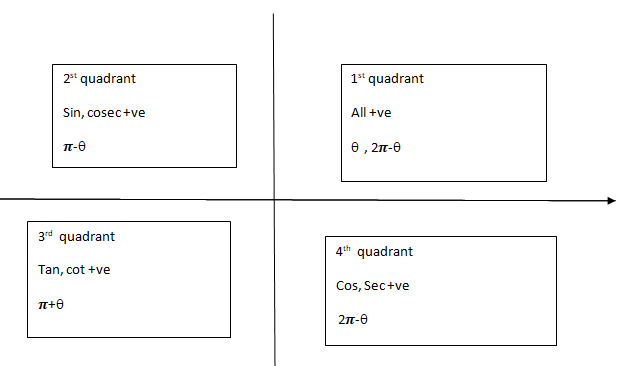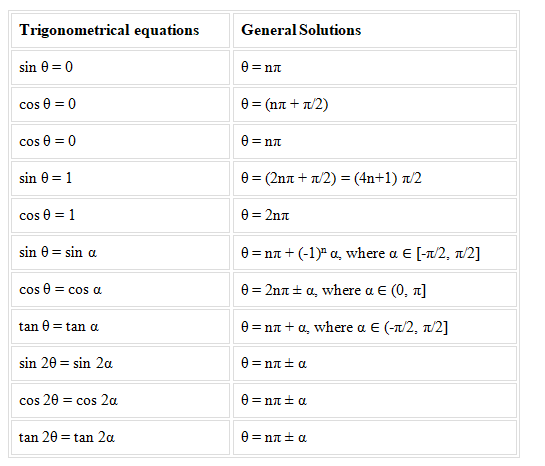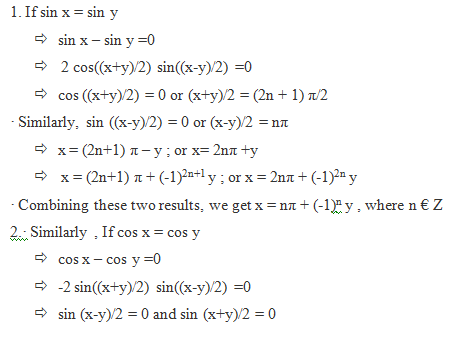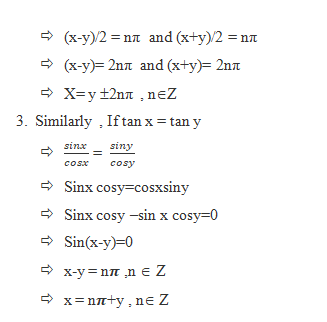- Books Name
- AMARENDRA PATTANAYAK Mathmatics Book
- Publication
- KRISHNA PUBLICATIONS
- Course
- CBSE Class 11
- Subject
- Mathmatics
Trigonometric Equations:
Equations having trigonometric functions of a variable is known as Trigonometric Equations.
The equation is not completely solved unless we obtain an expression for all angles which satisfy it.
Example: sin2x + 7 cos x – 7 = 0 ,
sin 3x + 3 cos2x = 7 , etc.
All trigonometric ratios are periodic in nature, a trigonometric equation has in general, an infinite no. of solution.
So , the solutions of trigonometric equation may be categorized as:
Types of Solutions:
- General solution
- Principal solution
Principal Solution :
The solutions of these equations for a trigonometric function in variable x, where x lies in between 0≤x≤2π is called as principal solution.
General Solution:
If the solution contains the integer ‘n’ ,which gives all solution, it is called as the general solution.
Sometimes:
Particular Solution:
A Specific Value of x (the unknown angle) which satisfy the given equation.
N.B.: 1. The General Solution. contains Principal Solution as well as Particular solution
2. Principal Solution always two

Table

Proof :
sin x = sin y implies x = nπ + (-1)n y , where n € Z and x and y are any real numbers.


Q 1: If f(x) = tan 3x, g(x) = cot (x – 60) and h(x) = cos x,
find x given f(x) = g(x). Also, if h(x) = 4/5, find cosec x + tan3x.
Solution: If f(x) = g(x), so tan 3x = cot (x – 50)
=>cot (90 – 3x) = cot (x-50)
=> 90 – 3x = x – 50
or x = 35
For h(x)=cos x and h(x) = 4/5, we have cos x = 4/5.
Therefore, sin x = 3/5, cosec x = 5/3 and tan x = 4/5
Or, cosec x + tan3x = (5/3) + (4/5)3 = 817/375 = 2.178
Q 2: Find the principal solutions of the equation tan x = – 1/(√3).
Solution: We know, tan(π/6) = 1/(√3)
Since, tan (π – π/6 ) = -tan(π/6) = – 1/(√3)
Further, tan (2π – π/6) = -tan(π/6) = – 1/(√3)
Hence, the principal solutions are tan (π – π/6) = tan (5π/6) and tan (2π – π/6 ) = tan (11π/6)
Q 3: Evaluate the value of sin (11π/12).
Solution:
sin (11π/12) can be written as sin (2π/3 + π/4)
using formula, sin (x + y) = sin x cos y + cos x sin y
sin (11π/12) = sin (2π/3 + π/4) = sin(2π/3) cos (π/4) + cos(2π/3) sin (π/4)
= (√3)/2 x √2/2 + (-1/2) x √2/2
= √6/4 – (√2)/4
= (√6-√2)/4
Q 4: Evaluate cosec x = 2.
Solution: We know, cosec x = cosec π/6 = 2 or sin x = sin π/6 = 1/2 .
- x = n π + (-1)n π/6
Q 5: Solve 5 cos2y + 2 sin y = 0.
Solution: 5 cos2y + 2 sin y = 0
- 5 (1 – sin2 y) + 2 sin y = 0
- 5 sin2y – 2 sin y – 5 =0
- sin y = 1.2 or sin y = -0.8.
Since sin y can not be greater than 1,
sin y = – 0.8 = sin ( π + π/3 )
or, sin y = sin (4π/3) and hence, the solution is given by y = n π + (-1)n (4π/3)
Q 6: Find the principal solutions of the equation sin x = (√3/2)
Solution: Let y=sin-1 (√3/2)
- sin y = (√3/2)
- sin y= sin( π/3) and sin (2π/3) = sin (π – π/3 ) = sin π/3 = (√3/2)
Therefore, the principal solutions are x = π/3 and 2π/3.

 KRISHNA PUBLICATIONS
KRISHNA PUBLICATIONS
